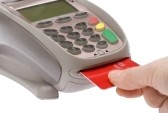 Online shopping has made it easy for consumers to compare products and prices from the comfort of their own home. You no longer have to drive all the way to the store only to discover that the item you’re seeking is out of stock, wasting fuel and polluting the environment in the process. But while you might appreciate the convenience offered by online shopping, you probably also have concerns about the safety of using your credit cards in cyberspace.
Online shopping has made it easy for consumers to compare products and prices from the comfort of their own home. You no longer have to drive all the way to the store only to discover that the item you’re seeking is out of stock, wasting fuel and polluting the environment in the process. But while you might appreciate the convenience offered by online shopping, you probably also have concerns about the safety of using your credit cards in cyberspace.
Identity theft is nothing new, but the combination of lax security measures and determined hackers has made for a perfect storm of mineable data. And the people willing to break into company databases in order to steal your sensitive data are not likely to have any qualms about selling it to the highest bidder or racking up charges using your credit, especially online, where no ID is required. However, you can find ways to use your credit cards in at least as safe a manner as if you were shopping in-store. Here are some guidelines to observe.
Shop on trusted sites. Although sites like Amazon and Sony have notoriously had their cloud networks hacked and data stolen in the past, you can feel pretty secure using them now, knowing that they’ve likely beefed up security in the wake of these PR disasters. And most major retailers that have expanded their operations into the online arena have certainly taken pains to make their customers feel safe. So while you might still be wary of virtual shopping via small, boutique sites, you should be able to shop at major retailers online with the same confidence you feel handing them your credit card in a real-world setting.
Look for the lock. Sites that are protected will feature a padlock icon, often next to the address bar on your web browser. You can click on it to find information about the protective software being used, but you can generally expect that any information you’re sending is being encrypted so that even if it is stolen, hackers won’t really be able to access your sensitive, personal data. If you don’t see this icon, you shouldn’t enter your credit card information.
Save receipts. It’s not entirely uncommon for glitches to occur in the ordering process, especially when people get tired of waiting and click the purchase button more than once. So it’s a good idea to check your order before you purchase to make sure it is accurate, and then save or print the receipt for anything you buy online. This will serve as proof if you end up getting double charged or otherwise wrongly billed.
Check your bill. If you’re not taking the time to look over your credit card bill when it arrives to make sure that the purchases listed aren’t fraudulent, you have no one to blame but yourself if you end up paying for someone else’s charges made with your card. This can be a great way to catch identity theft early, stop the spending, and recoup costs (since most credit card companies won’t make you pay for fraudulent activity on your account, so long as you report it in a timely manner). You can also ask your creditor to deactivate your card and contact you immediately in the case of purchases that don’t fit your spending habits.
Check your credit score. When you’re the victim of identity theft, it might not matter if you keep your credit card number safe. Thieves may take your information and use it to open other credit accounts that you don’t even know about. Even the best credit card companies might not spot this type of fraud. And in the meantime, your credit rating will go down the drain. For this reason it’s important to keep track of your credit score by ordering reports at least annually (you can order them for free at AnnualCreditReport.com). And some banks and creditors now offer to provide you with your current credit score on every bill, allowing you to track it monthly. If you’re going to enter your credit card number and other sensitive information online, such a program might not be a bad idea.




No Comments